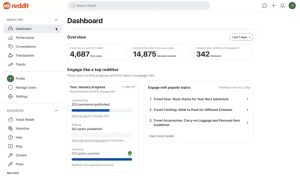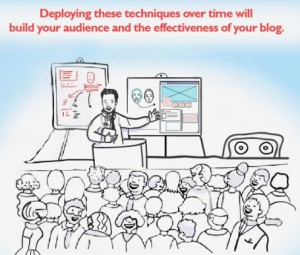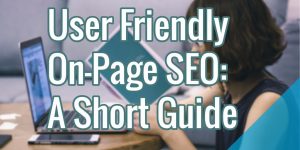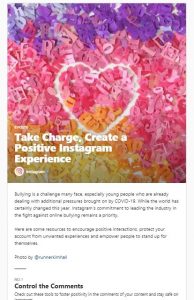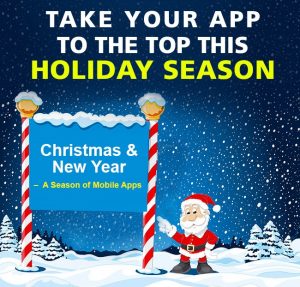You’ve decided to create a landing page for your company. You’ve signed up, chosen a template and picked out an appropriate color scheme. Quickly, you realize that building a landing page requires more than nice layouts and eye-catching colors alone – it needs content.
But now you’re stuck – clueless as to how to proceed.
If you find yourself stringing together words without much direction, here are some tips to help you write customizable, convertible copy for your new landing page.
What is Copy and Why Do You Need to Use It?
To write copy effectively, you need to know what it is and the purpose it serves.
Copy includes any text used to communicate your company’s message. It’s usually captivating and holds the interest of your intended audience. In sales, it’s used to convince a reader to make a specific purchase within a certain time frame.
 Communicating your company’s message
Communicating your company’s message
Also referred to as copywriting, it takes on multiple written forms: web and landing pages, newsletters, blog posts, social media posts, magazine ads, and more.
In essence, you’ll use copy to communicate how your products or services benefit (i.e., leads to results for) your intended audience in aims to convince them to purchase your valuable resources or offer you their personal information.
What Exactly is a Landing Page?
Landing pages are an extension of copywriting. Instead of multiple campaigns that can be found on a home page, ideally, there’s one campaign objective on a landing page. Copy and design are combined to guide the actions of your site visitors.
Landing pages normally float alone – they aren’t connected to your website’s primary menu. Traffic flows to your landing page from one or many of these channels:
- PPC marketing campaigns
- Links from an email newsletter
- Banner ads
- Links within blog posts or sidebar text
When visitors arrive on your landing page, they should have a clear indication of what it’s about and what you’d like for them to do. What might you want your visitors to do? Here are some examples:
Exchange their contact information for:
- Newsletters
- eCourses
- Access to industry-specific interviews (podcasts, videos, etc.)
- Online events
- eBooks
Warm them to the idea of:
- Signing up for a paid eCourses
- Purchasing a product
- Enrolling in your service offerings
Writing Customizable Landing Page Copy
The next big question is, “How do you combine the purpose of copy with the intended use of a landing page to reach your marketing goals?”
It’s all about the art of customizing copy that speaks to your audience.
What if you’re building a landing page on PageWiz? How would you write copy for it?
For this example, we’ll pretend to be real estate agents who want to create a contact list of individuals who’ll view an open house within the next month.
Step One: Decide How You’ll Solve Your Audience’s Problem
Since your goal is to target a specific set of people – only those interested in viewing an open house in the next couple weeks – ensure your copy speaks to them.
Having specific copy that addresses your audience will not only yield more subscribers, but you’ll also reach the right audience for your marketing purposes.
In figuring out what your audience’s problem is, let’s look at key questions you should ask to help you formulate your copy:
What Challenges Does Your Audience Have?
Start looking at the problems and issues your audience faces and relate to that in your copy. If you can show you understand their problems, your audience will be more apt to listen to you.
For some services, you can lean on the pain points of individuals. For example, AppSumo’s business course shows you how to make $ 1,000 per month, and their target audience is customers who have failed at trying to start a business.

The course addresses this and promises a solution – to help readers build a profitable business with the right idea.
With our real estate example, we know our target audience is looking for the perfect home in the least amount of time possible.
So their challenge is time and finding the right home.
What Does Your Audience Need to Solve These Problems?
After empathizing with your audience’s challenges, you can now let them know how you will solve their problems.
The best approach is to keep it simple. There’s no need to hype it up with bold phrases, exclamation points, italics or all caps. The best marketing copy is simple.
Take MailChimp for example. Their headline Send Better Email speaks to the heart of their audience. It’s the solution they need.

For our real estate example, our audience needs to know what homes are available, along with price, location, and included amenities.
Because they are pressed for time, having an organized list with the exact features they want will be extremely helpful to them. It also helps them make decisions quickly and efficiently.
How Can Your Company Offer a Specific Solution?
When coming up with a solution, make sure it’s unique and exclusive to your subscriber list.
No one will opt-in if the lead magnet is too broad, general or easy to obtain online. Remember, they are giving up their email to receive your great offer.
With our real estate example, this precise real estate company can offer exclusive, detailed listings, professional agents, and impeccable service.
They are known for showcasing properties quickly according to the clients’ preferences.
Letting the audience understand the value your service has above others, will help tip the scales towards opting into your list.
In What Format Will Your Company Provide the Lead Magnet?
Think about how you want to deliver your message. Look at your target audience.
Are they too busy to read an eBook? Maybe a concise white paper would benefit them more.
Does your audience crave your content and engage with you on social media? Perhaps something more personal and catered to your audience – like an eCourse or webinar – might resonate well with them.
For the real estate lead magnet, you’ll want to:
- Offer exclusive open house listings
- Provide a free checklist clients can use during each open house
- Request the reader’s contact information in exchange for both lists
Dig deep into your ideal audience persona to understand how you can best deliver your information.
Step Two: Cater Your Copy to Your Ideal Audience
Whether you’re selling a product or capturing personal information, your copy should connect with your ideal audience. There are plenty of guides written to help you research your audience. That’s not what we’ll discuss here.
Let’s instead focus on the core elements of a landing page and practice writing those sections.
Generally, landing pages are comprised of a headline, subheading, short description, body copy, image, testimonials and call-to-action.
Headline
This is where you want to draw your client in. Think of the headline as a concise 10-15 word summary of your entire landing page.
This is the most important part of your copy. In a study by Microsoft Corporation, they found the attention span in readers for digital content is only eight seconds.
To capitalize on those precious seconds, have a strong, value-positioned headline to pique your reader’s interest and warm them up to your offer.
In our real estate example, a possible headline is:
“Step Into Your New Sunset City Home Within a Month – It’s Waiting for You”
When you tell your visitors they can find their new home within a month, it cuts to the core of what they truly want – to find the perfect home in the shortest amount of time.
Subhead
This copy supports your headline claim. Some important things to consider when writing your subhead are:
- Stress the benefits by mentioning what you can do for your visitors and how you can solve their problem
- Sum up exactly what you will do for your target audience in a short sentence
- Stay positive by focusing on the benefits and not the problem; you’ll hook your visitors into wanting what you’re marketing to them
You can see this in our real estate subhead example:
“Discover the home that’s a perfect fit for you and your family using our simple-to-use software.”
Make it easy to understand – in plain English – what your service will do to help your visitors solve their problem.
Short Description
Use storytelling to briefly explain how visitors can benefit from your services. Help them imagine how they’ll benefit from your services.
This helps identify your target audience when you can provide a relatable story that causes them to say, “Yes that’s me!”
Here’s our example: “You’ve spent months, maybe even a year or more searching for a place you can call home. Each week you visit house after house, but you’ve yet to find the right fit. At The Right Place Realty, we help you clearly define your new home needs, and then you can relax while we do the rest.”
“We’ll ask you a few questions to better understand what you want and we’ll provide you will a list of exclusive open houses to attend in-person or virtually – all within a fraction of the time you’d spend doing this on your own.”
Body Copy
This is a more detailed explanation of the benefits offered to your visitors. You want to stress how your service is better than other competitive services.
You also want to walk through how your target audience will benefit from your service.
Let’s see what this looks like in our real estate example:
“Typical open houses are random events. You scan a listing while taking into account its location, price, features, and the hours you can visit. But at The Right Place Reality, we take all the guesswork out of creating a list of houses to view.”
“It can be a confusing and frustrating process for anyone. It’s also time-consuming for most of us, often taking several months to purchase and move into a new home. But, we won’t stop until we help you step into the place you feel comfortable, and envision resting your head each night.”
“With our state of the art software, we’ll enter your preferences into our system during our first meet-up. You’ll then receive a list of homes in the area that meet or exceed your criteria. We’ll even provide you with a checklist to take with you while exploring each house on the list.”
“There’s no need to wander aimlessly from house to house, wishing the next house you step into will lead you to ‘the one.’”
Alluring Image or Video
Visuals should be supportive of your headline and claims. These might be images of the outcome, the process or how the reader will benefit from your services.
 An alluring image for a real estate landing page
An alluring image for a real estate landing page
Here are two examples we can use for our real estate landing page:
This landing page could show images of cozy interiors and pleasant exteriors. Images that can also be included are:
- Schools and shops in the area
- Home features (Pools, appliances, garage, pool, and so on)
As another example, we can include a video walk-through of a home most typical in the area.
Testimonials
Provide social proof that you deliver what you claim. This follows the bandwagon effect or the social proof principle.
People follow other people. We put more value on something that many people form a strong opinion about. So, if you show many people love your service or product, interested visitors will jump on the bandwagon and be more apt to join.
With our real estate example, this might look like:
“To get a feel for how this process might work for you, read others’ experiences below.”
“The Right Place Realty helped us find the home of our dreams! We’ve been searching for more than 6 months and with The Right Place Realty, in less than two weeks, we found what we’d been looking for. – Jenny S.”
“We are convinced we would not have found the right home were it not for The Right Place Realty. They streamlined the process making it easy for us to spend more time settling into our home than looking for one. – Carter Z.”
Call to Action (CTA)
Directly communicate how you’d like your site visitor to proceed. Your CTA has to be strong and directive.
Use power words in your CTA to increase conversion rates. To find out which words produce the best conversion, run split tests.
For example, Steven MacDonald, online marketer, helped the company he was working with, launch a trial version of CRM software. He tested several CTAs by changing a few words:
From his testing, he learned that Start Your Free Trial resulted in twice as many sign-ups.
For our real estate example, we might use, “Take the Next Step,” as our button copy.
We would then make these highlights as part of our CTA:
- “Simply provide us with your name, best phone number, and email address.”
- “We’ll schedule a consultation using our patented software.”
- “And as a bonus, you can immediately download an extensive checklist to use when assessing your new home.”
- “Our real estate agent will be with you every step of the way.”
Customizable Landing Page Copy Highlights
You can use the formula above to customize content on your own landing page. To summarize, here are eight key points:
- Write in a straightforward manner.
- Use sensory language that tells a story, but also keep it simple.
- Always remember your landing page goal of providing a solution for your site visitors’ pain points.
- Focus on the benefits – how can your offer yield results for your visitors?
- Compose your headlines as if they’re landing page summaries.
- If you don’t have any client testimonials, grab statements written about your company on social media accounts, take a screenshot, and add them to your landing page.
- Incorporate images or other visual media to support your claims and help visitors visualize the benefits of your offerings.
- Lastly, remember to focus on only one campaign objective – focusing on more than one defeats the purpose of a landing page.
Landing page copy varies by business, but we’ve covered some essential elements that you can use to create a strong landing page that leads to conversions.
Customizable copy takes into account the needs of your specific audience and the ways your company can fulfill those needs. Genuine and informative copy that visitors can trust is what leads to conversions.
Tell us in the comments how you will use this information for your next product or service.
Digital & Social Articles on Business 2 Community(56)
Report Post



